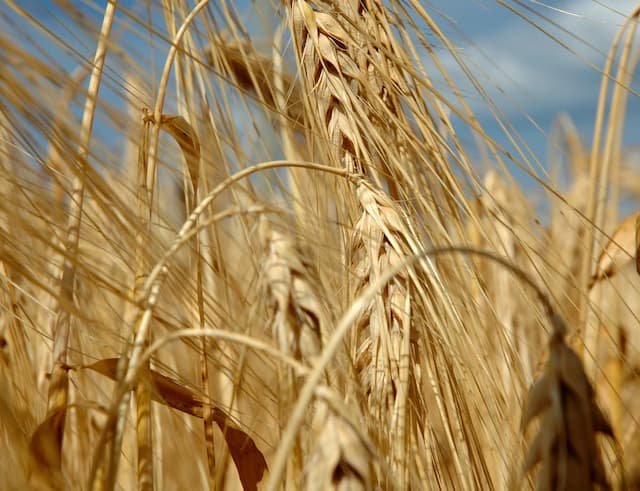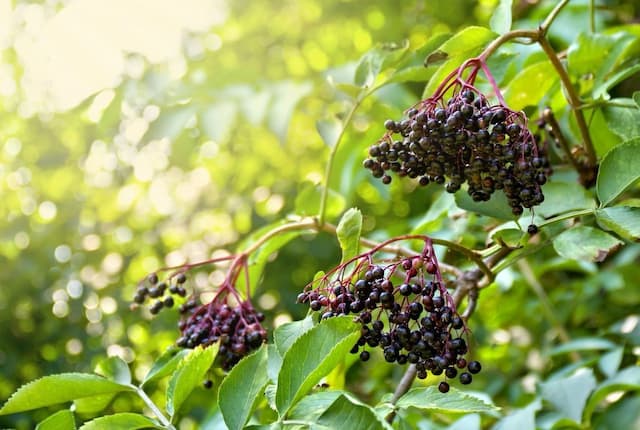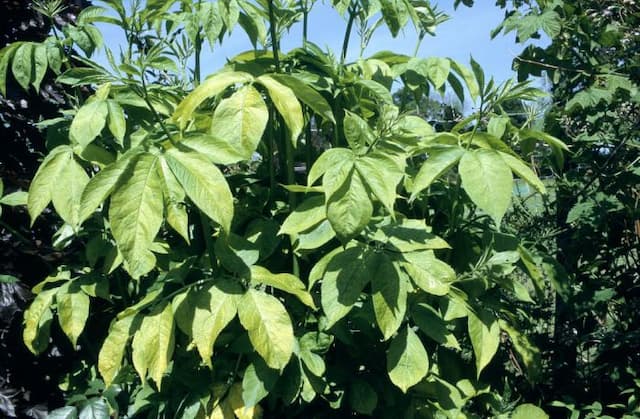Laurustinus 'French White' Viburnum tinus 'French White'

ABOUT
'French White' is a vigorous bushy evergreen shrub to 3m, with dark green ovate leaves and flat cymes of white flowers in late winter and spring, followed by blue-black berries
About this plant
 Names
NamesFamily
Adoxaceae
Synonyms
Laurustinus, French White Viburnum
Common names
Viburnum tinus 'French White'
 Characteristics
CharacteristicsLife cycle
Perennials
Foliage type
Evergreen
Color of leaves
Dark green
Flower color
White
Height
6-12 feet (1.8-3.7 meters)
Spread
6-12 feet (1.8-3.7 meters)
Plant type
Shrub
Hardiness zones
7-9
Native area
Mediterranean
Benefits
 General Benefits
General Benefits- Ornamental Value: French White, a variety of the laurustinus plant, offers year-round visual interest with its evergreen foliage, white flowers, and blue-black berries.
- Easy Maintenance: This plant is well-known for its low-maintenance needs, making it a popular choice for gardeners of all skill levels.
- Drought Tolerance: Once established, laurustinus 'French White' demonstrates a good level of drought tolerance, requiring less frequent watering.
- Wildlife Attraction: The flowers provide nectar for pollinators, while the berries are a food source for birds, making it beneficial for biodiversity.
- Hedging and Privacy: With its dense growth habit, laurustinus 'French White' is ideal for creating hedges and privacy screens in garden settings.
- Adaptable to Various Soils: It thrives in a range of soil types, provided they are well-drained, which allows it to be planted in many different garden situations.
- Shade Tolerance: This shrub can tolerate partial shade, which makes it versatile for planting in different areas of a garden that may not receive full sunlight.
- Seasonal Interest: Blooming in late winter to early spring, laurustinus 'French White' adds interest during a time when many other plants are dormant.
- Pest and Disease Resistance: Generally, this variety of viburnum is resistant to many pests and diseases, reducing the need for chemical treatments.
- Coastal Suitability: Being tolerant of salt spray and windy conditions, laurustinus 'French White' is an excellent choice for coastal gardens.
 Medical Properties
Medical PropertiesThis plant is not used for medical purposes.
 Air-purifying Qualities
Air-purifying QualitiesThis plant is not specifically known for air purifying qualities.
 Other Uses
Other Uses- Viburnum tinus 'French White', commonly referred to as Laurustinus, can be used as a natural hedge or privacy screen due to its dense foliage.
- The branches of Laurustinus can be cut and used in floral arrangements, where they provide a lush background to highlight other flowers.
- Laurustinus's dense growth habit makes it suitable for topiary work, allowing gardeners to create intricate shapes and designs.
- The plant can serve as a noise buffer in urban gardens where traffic noise is an issue, as its thick foliage can help absorb sound.
- Laurustinus can be grown in large containers to decorate patios, balconies, or entranceways with its ornamental flowers and foliage.
- Due to its resistance to salt spray, Laurustinus can be used in coastal landscaping to provide greenery in challenging environments.
- Its foliage can serve as a backdrop in photographic shoots, offering a natural and textured green element to compositions.
- In wildlife gardens, Laurustinus can provide shelter and nesting sites for birds due to its thick and robust branching.
- The strong structure of the plant makes it a good candidate for training as an espalier along walls or fences for a decorative effect.
- Mature Laurustinus shrubs can be used to create a living archway in a garden, particularly when planted in pairs with their branches trained to meet overhead.
Interesting Facts
 Feng Shui
Feng ShuiThe Laurustinus is not used in Feng Shui practice.
 Zodiac Sign Compitability
Zodiac Sign CompitabilityThe Laurustinus is not used in astrology practice.
 Plant Symbolism
Plant Symbolism- Renewal: Viburnum, in general, is associated with the renewing and rebirthing aspects of spring as it is one of the first plants to bloom, signaling the end of winter.
- Perseverance: As a plant that can withstand a variety of conditions, the 'French White' variety embodies the quality of perseverance and adaptability.
- Protection: Historically, Viburnum species were sometimes planted around homes for the belief that they offer protection to the inhabitants.
- Fidelity: The evergreen nature of Viburnum tinus 'French White' can symbolize faithfulness and the endurance of love over time.
- Abundance: With its plentiful white blooms, the plant may represent abundance or overflowing generosity.
 Water
WaterLaurel tinus, or Laurustinus, requires consistent moisture but does not like to be waterlogged. It's best to water the plant deeply once a week, applying about 1 to 1.5 gallons of water each time, depending on the size and maturity of the plant. During hot and dry periods, the frequency might need to increase to twice a week. In contrast, reduce watering in the winter when the plant is not actively growing. Ensure the soil is well-draining to prevent root rot and that you water at the base of the plant to avoid wetting the foliage.
 Light
LightLaurel tinus thrives in locations with full sun to partial shade. Ideally, plant it where it can receive at least four to six hours of direct sunlight daily. If grown indoors or under a shade, ensure that it still gets a good amount of bright, indirect light to promote healthy growth and flowering.
 Temperature
TemperatureLaurel tinus is hardy and can tolerate a temperature range from around 10°F to 80°F, but it prefers a mild climate. The ideal temperature for robust growth ranges between 60°F and 75°F. Be cautious of extreme cold, as temperatures below 10°F could potentially damage the plant.
 Pruning
PruningLaurel tinus should be pruned to maintain shape and encourage bushier growth. The best time for pruning is in late winter or early spring, just after the plant has finished flowering. Pruning annually or biennially promotes healthy growth and prevents the plant from becoming too leggy.
 Cleaning
CleaningAs needed
 Soil
SoilLaurustinus 'French White' thrives in well-draining soil with a mix of two parts loam, one part sand or perlite, and one part peat or well-rotted compost. The preferred soil pH for this shrub is slightly acidic to slightly alkaline (pH 5.6 to 7.5).
 Repotting
RepottingLaurustinus 'French White' should be repotted every 3 to 5 years or when the root system has outgrown the current container, using an appropriately sized pot to accommodate growth.
 Humidity & Misting
Humidity & MistingLaurustinus 'French White' is tolerant of a range of humidity levels and does well in average outdoor humidity, without the need for specific humidity adjustments.
 Suitable locations
Suitable locationsIndoor
Place in bright indirect light and ensure good air circulation.
Outdoor
Plant in well-draining soil in a sunny or partial shade spot.
Hardiness zone
7-10 USDA
 Life cycle
Life cycleViburnum tinus 'French White', commonly known as Laurustinus, begins its life cycle with seed germination, which requires exposure to a period of cold to break dormancy—a process called stratification. Following germination, the seedling emerges and develops a root system and foliage, transitioning into the juvenile stage where it experiences rapid vegetative growth. Once the plant reaches maturity, which can take several years, it starts the reproductive phase, producing clusters of small, white flowers in late winter to spring that are attractive to pollinators. After pollination, the flowers give way to blue-black berries (drupes), which are dispersed by birds and animals, allowing for the possibility of new plants to take root. The mature shrub can continue to flower and produce fruit annually for several years, with a lifespan that can extend well over a decade in suitable growing conditions. Finally, as the plant ages, it will enter a phase of senescence, with reduced vitality and productivity, eventually leading to its death.
 Propogation
PropogationPropogation time
Spring-Early Summer
Viburnum tinus 'French White', commonly known as Laurustinus, can be propagated through semi-hardwood cuttings. The optimal time for taking these cuttings is during the summer, typically between June and August, when the new growth has begun to mature. To propagate using this method, you should select healthy, semi-mature stems and cut lengths of about 4 to 6 inches (10 to 15 cm). Remove the lower leaves and dip the cut end in a rooting hormone to increase the chances of successful rooting. Plant the cuttings in a mix of peat and perlite, ensuring a high humidity environment, such as using a plastic cover to retain moisture. Rooting often occurs within a few weeks, after which the young plants can be potted on and eventually planted out in the garden once they are well established and the danger of frost has passed.




![Elder [Black Tower]](/_next/image?url=https%3A%2F%2Fplants-admin.emdemapps.com%2Fimages%2Fplants%2F%2Fimages%2F604b5cad99578.png&w=640&q=75)




